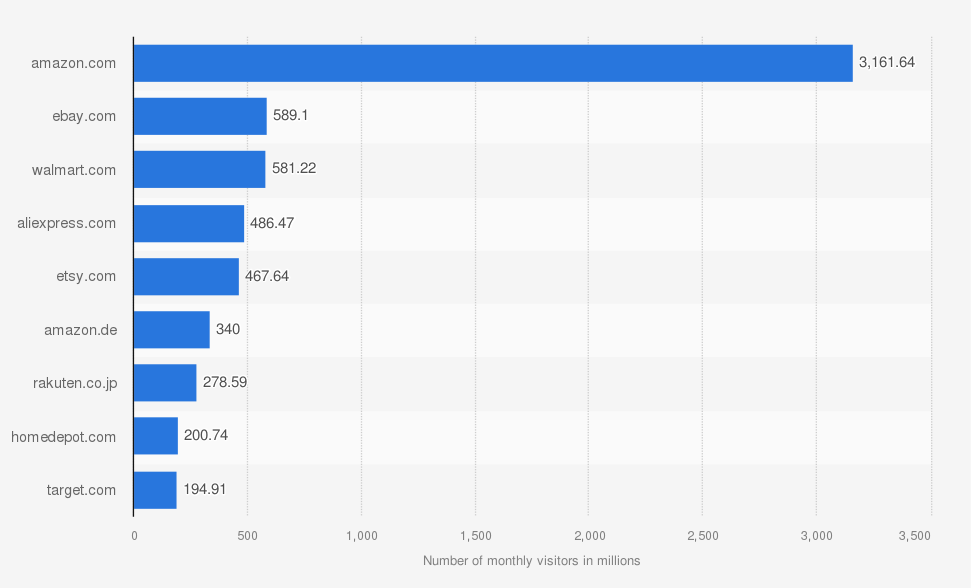Table of Contents
- 1 What Are the Important Trends of Online Retailers in 2025?
- 2 Who Is Included In the Ecommerce Market?
- 3 Where Are Customers Shopping: Top Online Retailers in 2025
- 4 Which Biggest Online Retailers Are Gaining or Losing Consumer Favor?
- 5 How Often Do Clients Shop At Online Retail Stores?
- 6 Where Are Consumers Searching for Products Online?
- 7 Are Product Reviews So Essential?
- 8 Online Retail Stores: Final Thoughts
 The eCommerce realm is always changing. More sellers are launching or improving their digital stores to attract clients. A recent study shows that eCommerce will account for more than 20.4% of general retail sales worldwide in 2023. It indicates the shopping world is increasingly becoming crowded.
The eCommerce realm is always changing. More sellers are launching or improving their digital stores to attract clients. A recent study shows that eCommerce will account for more than 20.4% of general retail sales worldwide in 2023. It indicates the shopping world is increasingly becoming crowded.
The burst in eCommerce brands can be explained by many aspects, with the preceding Covid-19 pandemic becoming the major one. The uncertainties caused by the lockdown and pandemic measures have caused many changes in client behavior, turning offline traffic into digital retail shops.
Keeping on top of changing buyer behavior and other trends is not an option for digital stores. It’s a necessity. While multiple things surrounding digital retail might be evolving, below are the tendencies of the largest digital retailers impacting businesses now and in the future.
What Are the Important Trends of Online Retailers in 2025?
In 2023, online customers care about pricing levels and opt for free and fast shipping. Most of the traffic is brought by direct-to-site advertisements, SEO optimization, as well as social media and email marketing. At the same time, both mobile and desktop website options have equal weight.
The most significant trends of digital shopping in 2023:
- Pricing matters to buyers;
- Low shipping costs and fast delivery are a priority;
- Second-hand shopping is growing;
- Email, SEO, and direct-to-site bring most of the traffic;
- Social media grows sales;
- Both mobile and desktop sites are equally important;
- Customers shop online via Amazon searches;
- High shipping costs are the primary reason for cart abandonment;
- Digital consumers buy a lot of entertainment;
- Americans prefer PayPal over all other digital payment methods;
- Online feedback is as important as personal recommendations.
Pro tip: SageMailer can get up to 37% more Amazon reviews and seller feedback. With the help of our tool, you can send review and feedback requests and create campaigns tailored to the order status or specific ASINs.
Who Is Included In the Ecommerce Market?
So, where exactly are all these digital sales taking place? This list is long – your neighborhood shop, local stores, non-traditional “retailers,” for example, the FB marketplace, and those offering non-fungible tokens to bigger retailers (like those we will review below) make up the retail market.
The main item clients shop for on the Internet is beauty, clothing, electronics, and home goods. With mobile gadgets in hand, companies in the United States and other countries are creating online environments that attract buyers. And as we indicated above, eCom demand keeps increasing.
While small and mid-sized businesses make up a good portion of e-commerce sales, we are looking at the biggest retail businesses ranked highest.
Some of these brands provide in-store shopping in addition to their shopping site. And you will notice a few retailers that created their mark solely with an online store (the most famous being Amazon). The list will give you the inside scoop on clients’ preferred vendors and online shopping techniques.
Where Are Customers Shopping: Top Online Retailers in 2025
Of the biggest online retailers, five brands are dominant in the market. These are Amazon, which gets more than the totals of the other four, Walmart, Apple, eBay, and Target. According to Statista, the top retailers in the U.S.A. as of September 2023 are Amazon with 38 percent of the U.S. e-commerce market, Walmart with 6.3 percent, Apple with 3.9 percent, eBay with 3.5 percent, and Target with 2.1 percent.

Which Biggest Online Retailers Are Gaining or Losing Consumer Favor?
In-store vendors — including Kohl’s, Lowes, and Best Buy — demonstrated a continued drop in popularity. On the other hand, buying online at Amazon, eBay, Target, and Walmart remains popular.
Clients have been purchasing from the following vendors more frequently within the last two years:
- Albertsons.com – up 92%
- Houzz – up 120%
- Instagram Shop – up 153%
How Often Do Clients Shop At Online Retail Stores?
If you wish to purchase something on the Internet, you need to go online. However, according to the recent 2021 Pew Research Center report, 7% of American adults never use the Internet and are, thus, unable to visit an online shop.
Otherwise, 85% of people reported using the Internet at least once daily, with 32% saying they were almost always online. Although it does not guarantee they will visit online stores, it shows that most US users can potentially be digital shoppers at some point.
Digital retail shops often make it simpler to purchase things individually, as you do not have to go out of your way to reach the shops. Besides, many sites provide free shipping. Nonetheless, the IPC surveyed individuals across 40 states and found that only 22% of them purchased on the Internet once a week. Instead, most respondents shopped on the Internet once every two weeks (25%) or once a month (28%).
This study also proved that 74% of Americans thought that more of their household purchases might be done online in the future. In turn, only 5% claimed that this could go down.
Where Are Consumers Searching for Products Online?
Most clients are now taking to platforms first when buying online. According to an August 2021 survey from eCommerce advertising agency ChannelAdvisor done by Dynata, 53% of American adults claimed they began merchandise searches at AMZ when preparing to make a digital purchase. Clients are also planning to lean on this marketplace heavily this holiday season. About 65% of respondents mentioned said they planned to search for gifts on Amazon, with 20 points ahead of Google.
Millennial and Gen Z AMZ Prime members were much more likely than those ages 40+ to share a negative advertising experience, as were male “super spenders” (paying $100 or more per month on the platform), in comparison with their female counterparts.
Are Product Reviews So Essential?
Most online stores have a feedback system, and some social platforms are large enough to evolve into shops. Such statistics demonstrate just how much somebody’s opinions and feedback influence our purchases.
According to the recent Bizrate survey on product reviews, only 8.7% of online buyers will typically purchase something without checking any reviews. Otherwise, more than 50% said they would check at least four testimonials before making a purchase.
Nonetheless, while most clients will only read a bunch of reviews, 38% said they could only trust products with over 50 reviews. Just 12.9% of Americans said the number of testimonials didn’t matter.
This survey also proved that only 32.7% did not trust sponsored feedback. It means that, based on the specific influencer and review, 67.3% of individuals had at least some trust in items after a sponsored review. Yet, as only 6.1% said they fully trust these reviews, they are often better for raising awareness for new clients.
Online Retail Stores: Final Thoughts
After seeing such eCommerce companies for the first time or realizing the revenue and power behind such brands, you’re probably more than curious about selling your products on one of the biggest online retailers worldwide, too.
Use this database of successful eCommerce businesses as an opportunity to expand your business with the techniques implemented by the most prominent players in the market. For instance, Amazon, the biggest digital retailer, is especially friendly to new merchants without much, to begin with. Besides, there is an active market for refurbished and used items, so you can begin selling things from thrift stores, yard sales, or around your house. AMZ’s listing commissions are relatively low, and as an individual merchant, you will not have to pay until something sells.
Now, if you want to take your online store to the successive league, we recommend using SageMailer! This feedback management platform provides tools to streamline dozens of processes, from customer service and communications to review generation. Register for a free 30-day trial and see how it works.

